We returned to Mongolia to look for the ghost of the mountains in February, for our annual snow leopard tour. Read our Snow Leopards of Mongolia 2025 Trip Report to find out about all of our sightings!

Highlights of the 2025 Snow Leopards of Mongolia Photo Tour
Snow Leopards: We were exceptionally lucky to have four sightings of snow leopards on this trip. The closest sighting was an incredible 40m away, the closest we’ve ever been to a snow leopard.
Mammals: We saw four total mammal species, about what we would expect for this system in winter. In addition to the cats, we saw Saiga, Ibex, and a hare. Of course, we were also in the presence of many domestic herds of animals, including Bactrian camels, cattle, sheep, goats and horses.
Birds: We saw 16 species of birds, a great achievement for this location at this time. Highlights included seeing several Golden Eagles soaring overhead, a quick look at Altai Snowcocks, and a very close sighting of a Bearded Vulture on the way to Snow Leopard Camp.
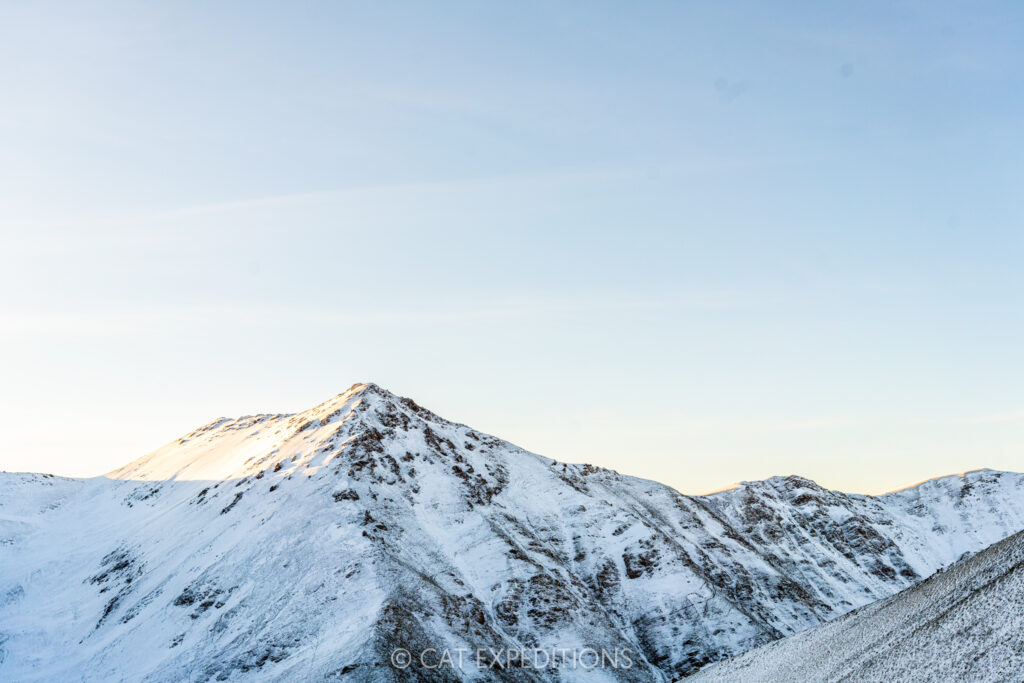
Detailed Snow Leopards of Mongolia Trip Summary 2025
Day 1: Everyone arrived safely and on time in Ulaanbatar. We had a great welcome dinner, gave a presentation on the days ahead and headed to dinner.
Day 2: We headed to the airport bright and early to catch our short, 2-hour flight to western Mongolia. Our faces tingled at the -22 degree air we encountered upon stepping onto the tarmac, certainly the coldest temperatures most of us have experienced.
We met our drivers, loaded into the car, and began the 2-hour drive out to Snow Leopard camp, passing through a vast expanse of white; something quite other-worldly. Along the way, we encountered several groups of Saiga Antelope (about 15 in total), though very shy and at quite a distance. Though we tried to approach a few times by car, the Saiga would run as soon as we got within 100 meters or so.
We arrived at camp late morning (elevation ~7,200 feet), enough time to settle in, eat some lunch, and head out to the field in the hopes of seeing our first Snow Leopard. We drove into the mountains through a valley and up to a large saddle overlooking the beautiful Altai Mountains, at an elevation of about 8,200 feet. Fairly quickly, the spotters found a pair of snow leopards up and over the saddle. We headed uphill and along a ridge about a mile, in total approximately 600 feet of elevation gain. Eyebrows, eyelashes, and even a few noses quite frozen, we walked, as a heavy fog rolled in around us. By the time we reached the viewing edge, we’d lost all visibility, and our team decided it was no longer safe to continue. With hopes the leopards might be there the next day, we headed back to camp to enjoy dinner.
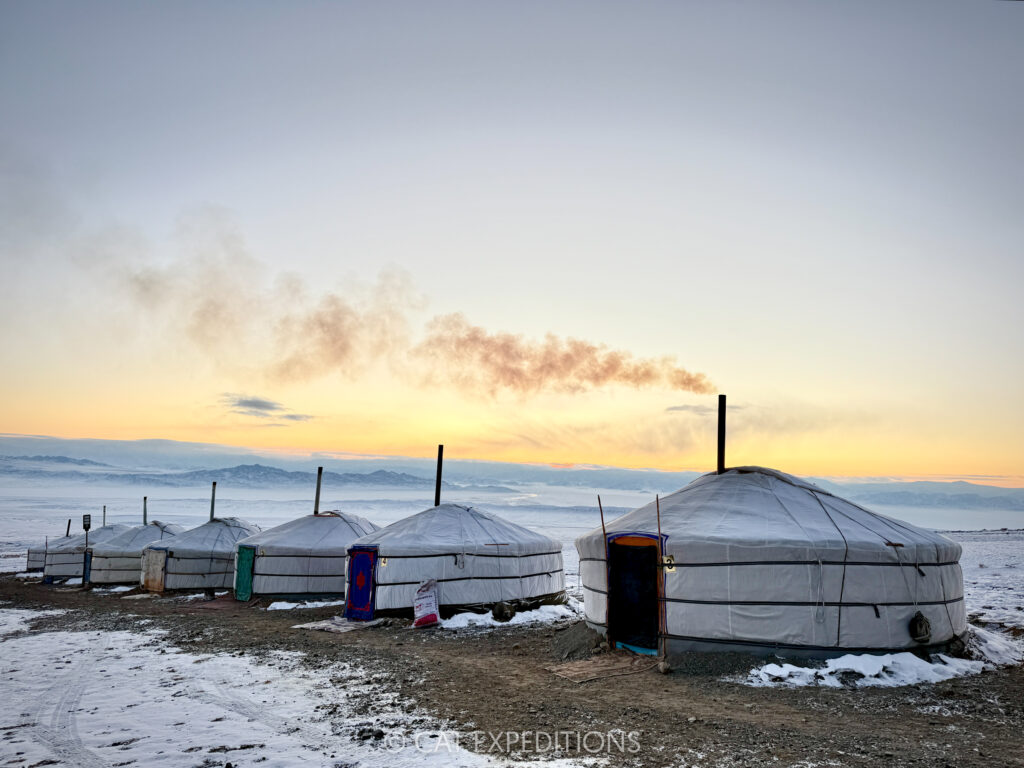
Day 3: We departed camp at 7:30a, just as the sun was rising. Before we left, our tracking team threw a handful of milk out into the landscape, an offering to nature to help us with our purpose and a plea to keep us safe on the mountain.
We made our way up a narrow valley shaped by a small, now frozen river. As soon as we pulled up, we saw Snow Leopard tracks dotting the area, some quite fresh. The guys headed down into the valley and into the mountains in search of a nearby cat. While we waited, our drivers lit juniper on a small rock tower, another shaman offering to the mountain.
While we had lunch in the sun, we got news from the spotters that a male Snow Leopard had been found resting in the same area as the day before. We repeated the same climb as the previous day, although this time with sun. We continued past our previous stopping point, down a steep rocky hillside. Our porters helped demonstrate the art of slip-sliding down the shale mountainside. We stopped for awhile at a rocky outcropping where you could see the resting snow leopard through the scope. Red-billed Choughs and Cinereous Vultures flew overhead as we waited for the cat to wake. Some of the group then continued down a bit further to try to get a view of the cat at eye level, the sighting about 200m away. We photographed the cat until the sun had set and it was time to go. Back at the rocky outcropping, we got one more view of it as it walked up the mountainside and out of sight.
It was a cold, grueling walk back up the mountain, but everyone did it with fantastic resolve and a positive attitude.
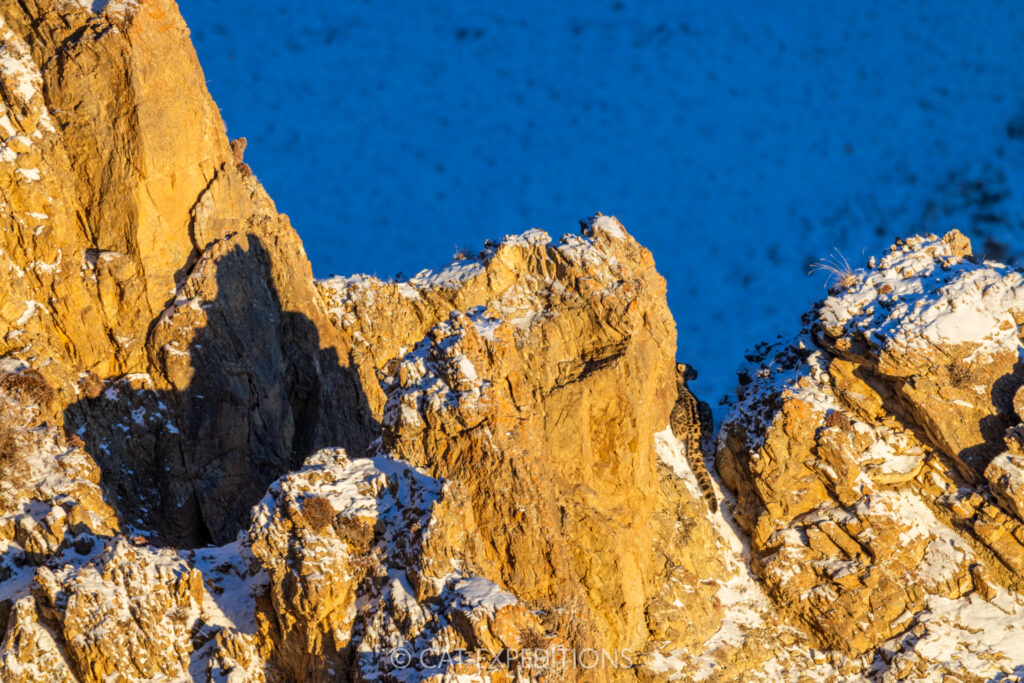
Day 4: We departed camp again at 7:30a and returned to the same valley. The same male Snow Leopard was soon found again in the same area. This time, it was best to start at the valley floor. We strapped on our crampons and walked along the frozen river, passing many Snow Leopard marking and spraying spots, and dozens of different tracks. After about 500 meters, we got to a nice open area where we could set up our tripods and see the cat from below.
The cat was resting out of sight, but we waited and saw about a dozen Ibex, some Chukars, and Cinereous Vultures. While we were having lunch, a local herder wandered into the area, and we were told that the cat had become very nervous by his presence. We had hoped to walk up a bit closer to the cat in the afternoon, but this change meant it was best for us to stay at the bottom so as not to push the cat off.
We continued to wait, and after an hour or so, the snow leopard moved. The Ibex became incredibly nervous, vocally alarming to each other, running from all sides of the mountains toward the cat to keep a close eye on the threat. We continued to wait, and finally saw the leopard jump down from its resting place and immediately out of sight.
However, the day was not over! We got word that the spotters had found a different leopard back up near the saddle. We drove back that way, and began a short walk traversing a shale hillside about half a mile, still steep, but we were able to use a small game trail. Part of the group stopped at this point, as the next portion to reach the snow leopard would be somewhat treacherous. The rest of the group continued along the game trail, crossed a small ravine, and then traversed the opposite mountainside, very steep and snowy. We squeezed through a small rock crevice, then slid on our butts down a steep ravine, and finally climbed up slightly to be at eye level with the cat, who was sitting in a small rock cave at about 40m distance, an incredible sighting.
We stayed and photographed for about 10 minutes, but then decided to leave and give the cat some space, as we felt he seemed slightly disturbed by our presence. We made the slow hike back, returning to the cars after dark around 6:30p.
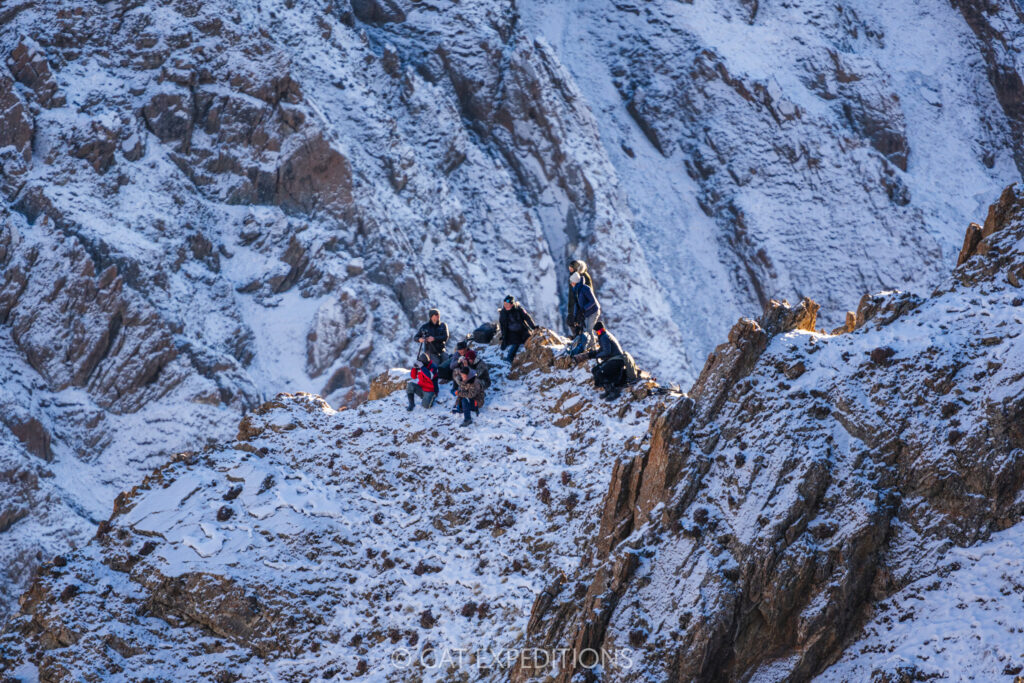
Day 5: 7:30a departure and -15 degrees Celcius. Along the way into the mountains, we stopped to say hello to a herd of Bactrian camels from the neighboring camp. We headed back into the valley floor and waited while the spotters followed up on some tracks. We watched a few Ibex as we waited, and explored the other tracks that spotted the valley floor, including fox tracks!
For lunch, we found a sunnier spot at the next valley over and enjoyed a rest in the sun while we continued to wait for news from the spotters. We did some birding while we waited, and saw some big flocks of Horned Larks and Twites along the slope edges of the valley. By 3:00p there had been no sightings, so we headed back to camp.
After some warm showers, we took a walk around camp in search of the camels and photographed them as the sun set.
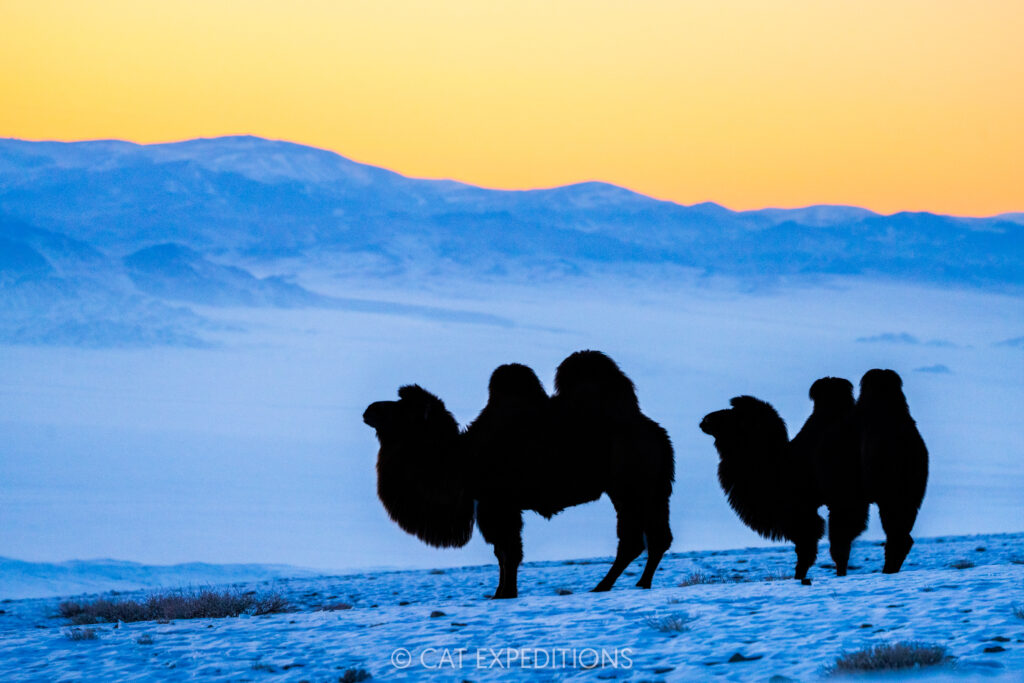
Day 6: We left 30 minutes earlier with the plan of heading to a further valley, but we quickly received news that one of our drivers, Oogna, who has a large sheep herd in the valley, had lost one of his sheep overnight to a snow leopard. His 18-year old son who now looks after his flock showed us the spot, very close to where we’d had lunch the day before. We watched as the spotters scaled both sides of the valley to get a better look at the kill. It was a small sheep, mostly eaten. The trackers spent the rest of the morning trying to find the cat, but could not find it.
After lunch, we returned to the other valley and very quickly the spotters found a cat resting in a similar place as the previous day. We headed back to the same spot we’d set up our tripods before, a short, but slippery walk atop the frozen river (thank goodness for crampons!).
We had a great view of the cat resting on a sunny outcropping, about 200 meters above us. We watched it sleep for a few hours while we tried to keep warm. A few times, it shifted position, and we got a view of its glorious tail sweeping across the rocks as it moved. Despite a herder, sheep, and loud barking dog very nearby, the cat rested unperturbed. Finally, around 5:15p, the cat got up. It appeared to have seen something, and we watched as it crept slowly up and away, disappearing as these cats do so well!

Day 7: This morning, we headed back up to the saddle, where the spotters set out to look for cats and we were grateful for the sunny spot. We entertained ourselves with birds, spotting a small group of Altai Snowcocks, and a passing Merlin, new species to add to our list. In the afternoon, the spotters (and even Sebastian) partook in some Mongolian wrestling.
Let’s just say, Sebastian was not the victor, but his spirit remained strong! By the afternoon, the cold wind had picked up considerably and no cats had been spotted. We headed back to camp, stopping for some petroglyphs and doing a small birding loop along the way where we spotted a Little Owl briefly, sitting atop the rocks. The sunset that evening was spectacular, and we welcomed the warmth of the gers as the last color faded from the day.
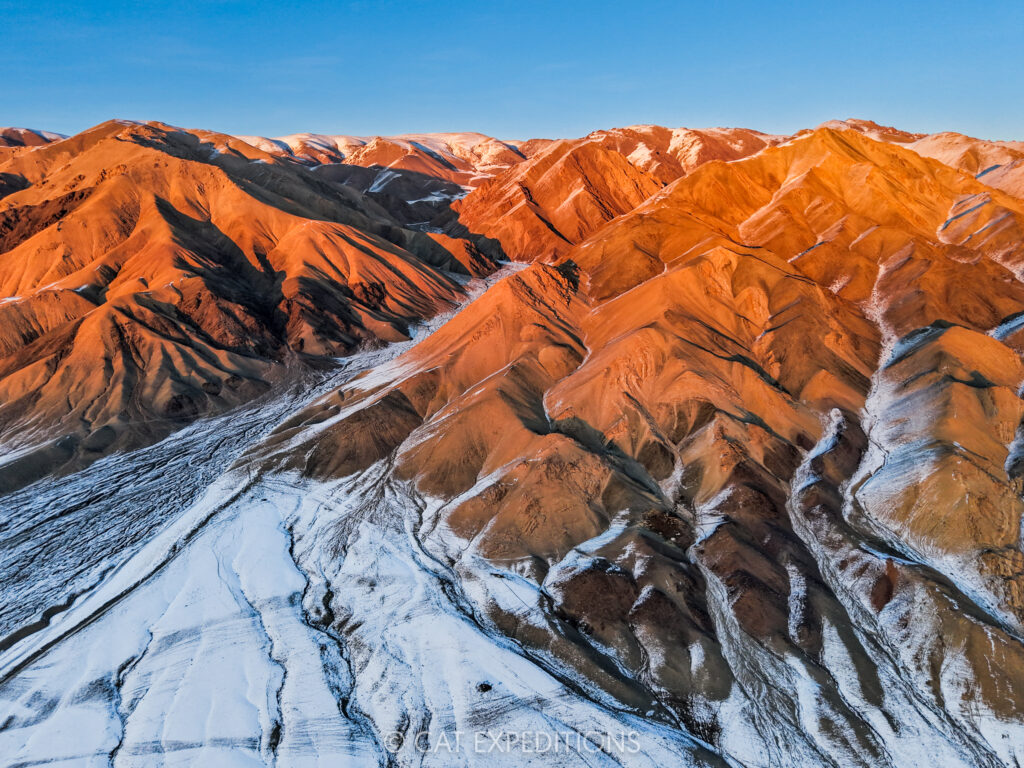
Day 8: The fierce wind awoke most of us around 4 in the morning, and with it a white, snowing landscape, which didn’t bode well for visibility or warmth. Our fearless spotters set out on their own, while we stayed at camp and waited for word. By lunchtime, the weather had passed and we decided to head to a new valley for our final afternoon, home to several caves that we thought the cats may be utilizing for refuge from the bad weather. The valley is a bit further of a drive, but a spectacular, wide valley. On this afternoon, an eerie fog hung low, but the spotters ascended quickly, searching for snow leopards in the mountain caves hidden from view far above. We waited and explored the new spot, admiring bones and rocks and the impressive views.
No cats were found, but we finished off the afternoon with a visit to a local family’s ger. The matriarch of the home served us salted sheep’s milk and let us ask questions about their way of life. Afterward, we headed back to camp, enjoying the last sunset and some camels along the way.
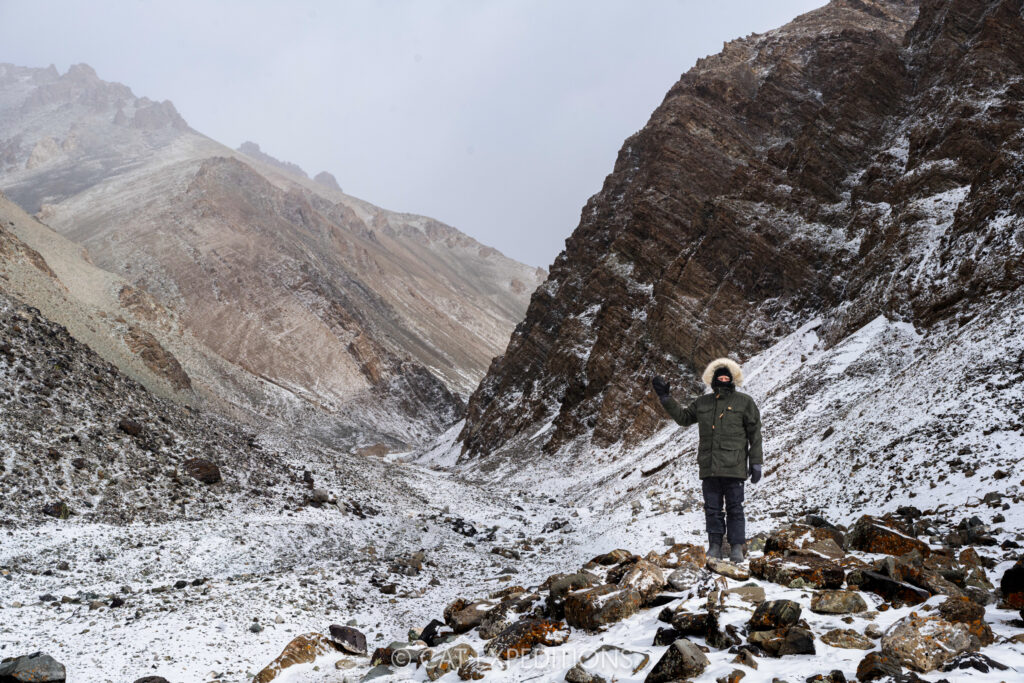
Day 9: We said our goodbyes to the camp staff and departed camp around 4:30a, headed back to Khovd Airport for our flight back to Ulaanbaatar. We got lucky with the traffic back to the hotel, welcomed the opportunity for some warm showers, and had our final group dinner.
Day 10: Most of us departed on our international flights home.
Snow Leopards of Mongolia Photo Tour 2024 Species List
Mammals
| Snow Leopard | Panthera uncia |
| Siberian Ibex | Capra sibirica |
| Saiga Antelope | Saiga tatarica |
| Tolai Hare | Lepus tolai |
Birds
| Altai Snowcock | Tetraogallus altaicus |
| Chuka | Alectoris chukar |
| Rock Pigeon | Columba livia |
| Hill Pigeon | Columba rupestris |
| Bearded Vulture | Gypaetus barbatus |
| Cinereous Vulture | Aegypius monachus |
| Golden Eagle | Aquila chrysaetos |
| Little Owl | Athene noctua |
| Merlin | Falco columbarius |
| Eurasian Magpie | Pica pica |
| Mongolian Ground Jay | Podoces hendersoni |
| Carrion Crow | Corvus corone |
| Common Raven | Corvus corax |
| Horned Lark | Eremophila alpestris |
| White-winged Snow Finch | Montifringilla nivalis |
| Twite | Linaria flavirostris |
